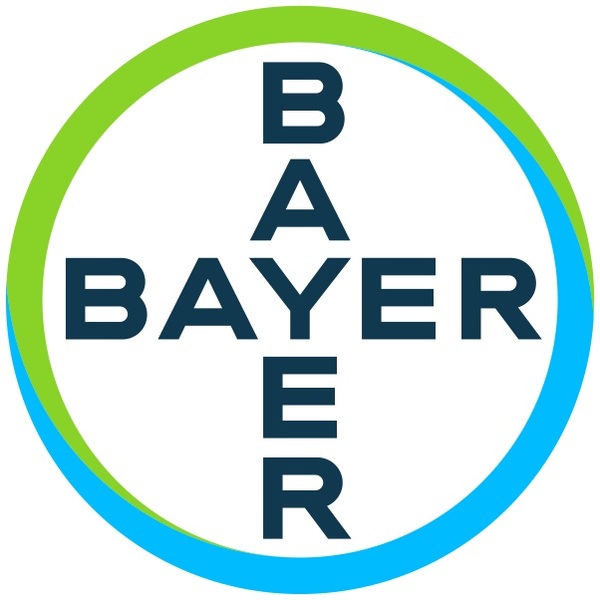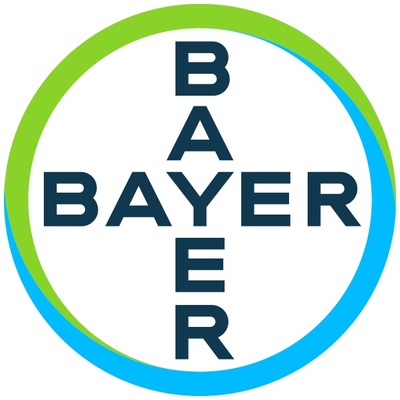


WHIPPANY, N.J., March 31, 2017 /PRNewswire/ -- Bayer today announced positive data on its investigational compound copanlisib, an intravenous pan-Class I phosphatidylinositol-3-kinase (PI3K) inhibitor with predominant inhibitory activity against PI3K-α and PI3K-δ isoforms. The Phase II CHRONOS-1 trial, an open-label, single-arm study evaluating patients with relapsed or refractory indolent non-Hodgkin's lymphoma (iNHL), met its primary endpoint of a pre-specified objective response rate (ORR). The results across all patient groups show an ORR of 59.2%, with a 12% complete response (CR) rate and a median duration of response (DOR) of more than 98 weeks, or 687 days (range 0-687). These data will be presented at the American Association for Cancer Research (AACR) 2017 Annual Meeting in Washington, D.C. in the Novel Agent and Intervention Clinical Trials session on April 4, 2017 from 3:05 p.m. – 3:20 p.m. EDT.

"Based on the National Comprehensive Cancer Network (NCCN) guidelines, inhibition of the PI3K pathway has been shown to be a promising therapeutic pathway in treating indolent lymphomas, like follicular lymphoma," said Martin Dreyling, Professor of Medicine at the University of Munich Hospital in Grosshadern.
The full analysis set comprised 142 patients, of which 141 patients had iNHL. At the time of analysis, median duration of treatment was 22 weeks and 46 patients remained on treatment. In the follicular lymphoma (FL) subset of CHRONOS-1 (n=104), copanlisib treatment resulted in an ORR of 58.7%, including a CR of 14.4% and a median DOR of more than 52 weeks, or 370 days (range 0-687). The safety was generally consistent with previously published data on copanlisib. The most common treatment-related adverse events were transient hyperglycemia (all grades: 49%/Grade ≥3: 40%), which did not show severity above Grade 4, and hypertension (all grades: 29%/Grade ≥3: 23%), which did not show severity above Grade 3.
"NHL is the tenth most common cancer worldwide and one of the most common cancers in the U.S.1,2 Despite treatment advances, most indolent NHL patients relapse after, or are refractory to, current therapies," said Robert LaCaze, Executive Vice President and Head of the Oncology Strategic Business Unit at Bayer. "The positive results from CHRONOS-1 are an important milestone and reflect the potential clinical utility of copanlisib in addressing the unmet medical need in patients with malignant lymphoma."
Other copanlisib data to be presented at AACR 2017 include preclinical analysis of copanlisib activity in B-cell lymphomas as a single agent or in combination with conventional and targeted agents and a study on the binding affinity of copanlisib.
Bayer is in discussion with the U.S. Food and Drug Administration (FDA) with respect to a New Drug Application (NDA), seeking accelerated approval of copanlisib for the treatment of relapsed or refractory FL who have received at least two prior therapies. The company has been granted Fast Track Designation by the FDA for copanlisib for this indication. Fast Track is a program designed to facilitate the development, and expedite the review of drugs to address unmet medical need in the treatment of a serious or life-threatening condition.
Copanlisib was also granted Orphan Drug Designation (ODD) by the FDA Office of Orphan Products Development in the U.S. in February 2015 for the treatment of FL and in February 2017 for the treatment of splenic, nodal, and extranodal subtypes of marginal zone lymphoma (MZL). The ODD program provides orphan status to drugs and biologics which are defined as those intended for the safe and effective treatment, diagnosis or prevention of rare diseases and disorders. The FDA regards any disease that affects less than 200,000 patients in the U.S. as rare.
About CHRONOS-1
CHRONOS-1 is a two-part, open-label, single-arm Phase II study (ClinicalTrials.gov Identifier: NCT01660451) evaluating copanlisib as a monotherapy in non-Hodgkin's lymphoma patients. CHRONOS-1 was designed to evaluate the efficacy and safety of copanlisib in patients with relapsed or refractory indolent NHL, including follicular lymphoma (FL), who received at least two prior therapies.The primary endpoint of CHRONOS-1 is the objective tumor response rate, with duration of response, overall survival, progression-free survival, quality of life, and safety serving as secondary endpoints.
About Non-Hodgkin's Lymphoma
Non-Hodgkin's lymphoma (NHL) is a cancer that starts in cells called lymphocytes, which are part of the body's immune system.3 It is the seventh most common cancer in the U.S.4 Estimates are that nearly 73,000 new cases of NHL will be diagnosed in 2017, including both children and adults.5 It accounts for more than 20,000 deaths per year.5 NHL comprises a heterogeneous group of malignancies with differing patterns of behavior and responses to treatment.6 NHL can be divided into two prognostic groups: the indolent lymphomas and the aggressive lymphomas.6 About 1 out of 5 lymphomas in the U.S. is follicular lymphoma.7 The term follicular means that the cells tend to grow in a circular pattern in lymph nodes.7
About Copanlisib
Copanlisib is a pan-Class I phosphatidylinositol-3-kinase (PI3K) inhibitor with predominant inhibitory activity against PI3K-α and PI3K-δ isoforms, being developed by Bayer. The PI3K pathway is involved in cell growth, survival and metabolism, and its dysregulation plays an important role in NHL.
Preclinically, copanlisib has been shown to inhibit PI3K-δ and PI3K-α isoforms at sub-nanomolar concentrations.The efficacy and safety of copanlisib has not been established. The broad clinical development program for copanlisib also includes Phase III studies in indolent NHL patients who have relapsed or are refractory to prior therapies. Information about these trials can be found at www.clinicaltrials.gov and www.chronostrials.com.
Copanlisib is not approved by the U.S. Food and Drug Administration, the European Medicines Agency or any other health authority.
About Oncology at Bayer
Bayer is committed to delivering science for a better life by advancing a portfolio of innovative treatments. The oncology franchise at Bayer includes three marketed products and several other compounds in various stages of clinical development. Together, these products reflect the company's approach to research, which prioritizes targets and pathways with the potential to impact the way that cancer is treated.
Bayer: Science For A Better Life
Bayer is a global enterprise with core competencies in the Life Science fields of health care and agriculture. Its products and services are designed to benefit people and improve their quality of life. At the same time, the Group aims to create value through innovation, growth and high earning power. Bayer is committed to the principles of sustainable development and to its social and ethical responsibilities as a corporate citizen. In fiscal 2016, the Group employed around 115,200 people and had sales of EUR 46.8 billion. Capital expenditures amounted to EUR 2.6 billion, R&D expenses to EUR 4.7 billion. These figures include those for the high-tech polymers business, which was floated on the stock market as an independent company named Covestro on October 6, 2015. For more information, go to www.bayer.us.
© 2017 Bayer
Bayer® and the Bayer Cross® are registered trademarks of Bayer.
Forward-Looking Statement
This news release may contain forward-looking statements based on current assumptions and forecasts made by Bayer Group or subgroup management. Various known and unknown risks, uncertainties and other factors could lead to material differences between the actual future results, financial situation, development or performance of the company and the estimates given here. These factors include those discussed in Bayer's public reports which are available on the Bayer website at www.bayer.com. The company assumes no liability whatsoever to update these forward-looking statements or to conform them to future events or developments.
1World Health Organization. GLOBOCAN 2012: Estimated Cancer Incidence, Mortality and Prevalence Worldwide in 202. http://globocan.iarc.fr/Pages/fact_sheets_population.aspx. Accessed March 2017.
2American Cancer Society. What Are The Key Statistics About Non-Hodgkin Lymphoma? https://www.cancer.org/cancer/non-hodgkin-lymphoma/about/key-statistics.html. Accessed March 2017.
3American Cancer Society. What is Non-Hodgkins Lymphoma? https://www.cancer.org/cancer/non-hodgkin-lymphoma/about/what-is-non-hodgkin-lymphoma.html. Accessed March 2017.
4National Cancer Institute, SEER Stat Fact Sheets: Non-Hodgkin Lymphoma. https://seer.cancer.gov/statfacts/html/nhl.html. Accessed March 2017.
5American Cancer Society. 2017 Cancer Facts & Figures. https://www.cancer.org/content/dam/cancer-org/research/cancer-facts-and-statistics/annual-cancer-facts-and-figures/2017/cancer-facts-and-figures-2017.pdf. Accessed March 2017.
6 National Cancer Institute. Adult Non-Hodgkin Lymphoma Treatment (PDQ®)–Health Professional Version. https://www.cancer.gov/types/lymphoma/hp/adult-nhl-treatment-pdq. Accessed November 2016.
7American Cancer Society.Types of Non-Hodgkin Lymphoma. https://www.cancer.org/cancer/non-hodgkin-lymphoma/about/types-of-non-hodgkin-lymphoma.html. Accessed March 2017.
PP-860-US-0061
Intended for U.S. Media Only
SOURCE Bayer